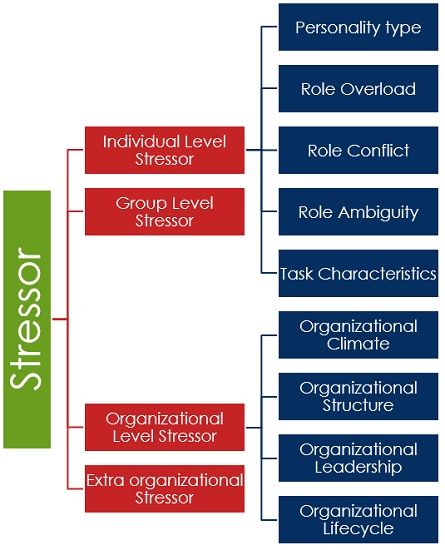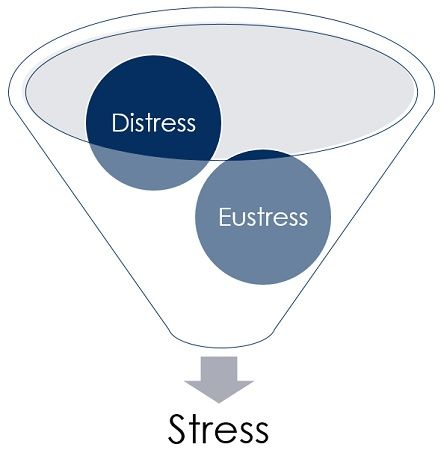Definition: In Human Resource Management, Stress is defined as a state of mental and emotional pressure or strain, caused by challenging or unfavourable circumstances. It is an outside force that rules an individual’s feelings and behaviour.
It is a person’s response to an external factor (stimulus, known as the stressor) in the environment and the outcome of such reaction. The stressor can be unreasonable or extreme pressure, placed on the employees, which can be a disturbing one.
Stress occurs due to discrepancies between situational demand and the employee’s ability to fulfil those demands, in essence, it is the imbalance between the perceived state and desired state, resulting in psychological, physiological and behavioural deviations. It is an inseparable part of work life.
Classification of Stress
- Eustress: It refers to positive stress, wherein the situation offers an opportunity to the individual to gain something. It is seen as a motivator that encourages people to meet challenges and, without which an individual lacks the spark needed to raise their level of performance.
- Distress: It is described as negative stress, in which an individual experiences insecurity or inadequacy because of helplessness, disappointment. Distress can cause cardiovascular diseases, alcoholism, marital breakdown, drug abuse, and much more.
Stressors – Sources of Stress
The basic sources of stressors are divided into four categories:
- Individual-level stressors: Stressors which are associated directly with an individual’s personality and job responsibility.
- Personality type: How a person experience stress depends largely on the type of personality he/she possesses. There are two types of personality, which are Type A and Type B.
- Role overload: Excess workload cause, increased pressure and tension in employees, that ultimately results in stress.
- Role Conflict: In an organisation, role conflict occurs where people experience competing demands. It can be an inter-role conflict which is caused when an employee has two opposing roles and personal role conflict, occurs due to the differences between personal values and organisational goals.
- Role ambiguity: When the employees are unaware of their responsibilities, authorities, powers, functions and performance expectations, it is known as role ambiguity.
- Task Characteristics: The characteristics of tasks also causes individuals to face stress, especially when it involves activities like decision-making, information exchange and monitoring work.
- Group level Stressors: The stress resulting from group dynamics and managerial behaviour are covered under this category. It can be due to the following reasons:
- Lack of cohesiveness
- Managerial Behavior
- Workplace violence
- Intragroup conflict
- Sexual Harassment
- Status Incongruence
- Organisational level Stressors: These stressors influence almost all the employees working in the organisation.
- Organisational climate: If the environment of the organisation puts excessive pressure of work on employees, causes high stress to employees.
- Organisational structure: The structure of organisation explain the level of authority and rules and regulations where decisions are taken. If in an organisational design the rules are more and the participation is less, then also the structure of the organisation works as a stressor to employees.
- Organisational leadership: Managerial style plays a crucial role in the development of employees. If there is a culture of the organisation to create tension, fear or anxiety, or work for long hours to complete the delegated work in a short time, otherwise they will be fired, will create unrealistic pressure on the employees.
- Organisational Lifecycle: As everything has a life cycle, organisations too passes through various stages of life, i.e. birth, growth, policy, procedure, theory, religion, ritual and last rites. The early phases of the life of the organisation are exciting while the latter ones are stress-prone.
- Extraorganizational Stressor: Those sources to stress, which are outside the organisation are included in this category. This covers stress caused by family, economy, status or lack of mobility.
Stress is linked to constraints and demands. Constraints stop an individual from doing something desired by him while demands imply the loss of something which an individual desires.
All people do not feel stress with the same intensity. Some are easily prone to stress, as they over-react to the factors causing stress while others have the capability to overcome any stressors. Therefore, it is a person’s perception, experience, attitude and social support; that determines how a person experience stress.


Abbsy says
Please, I would like to cite and quote from this website but don’t have a clue on the author and year of this particular article. Please help!!!
Urusha Maharjan says
Please provide the name of author, year , month and date about this article